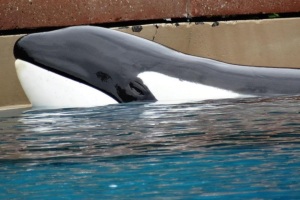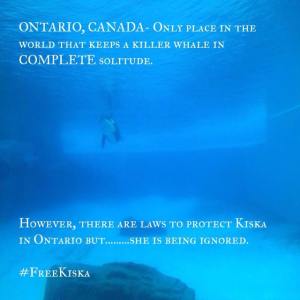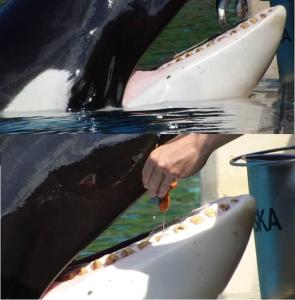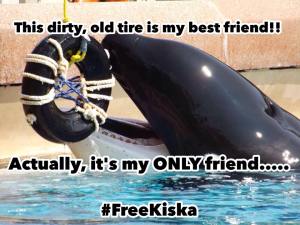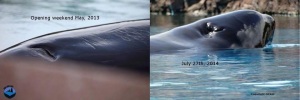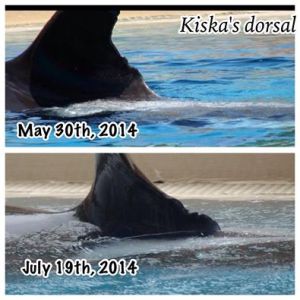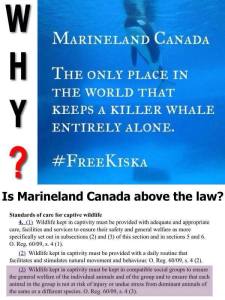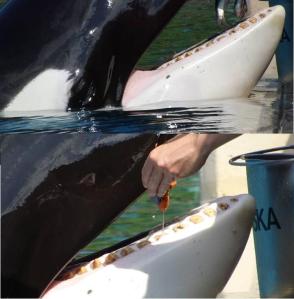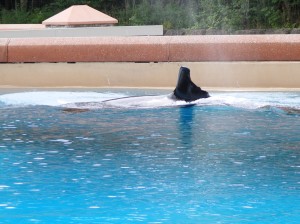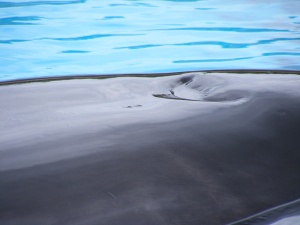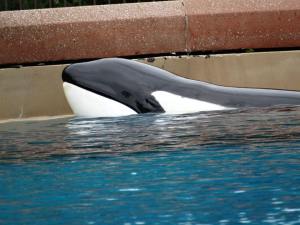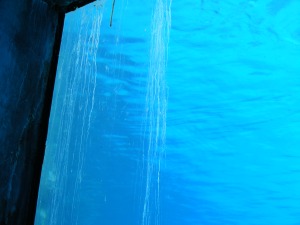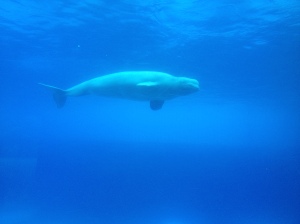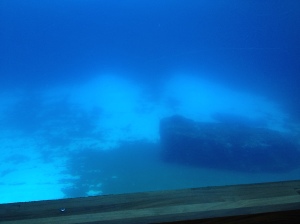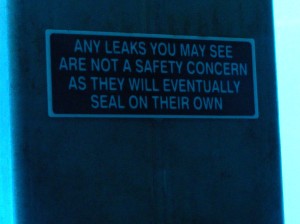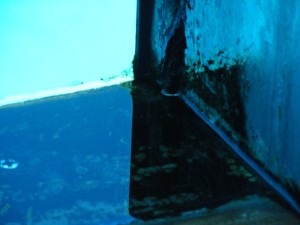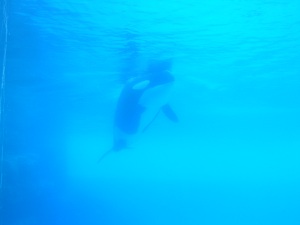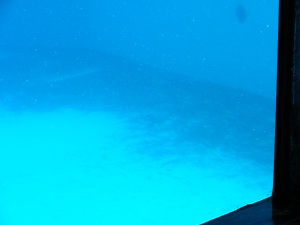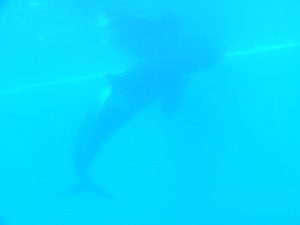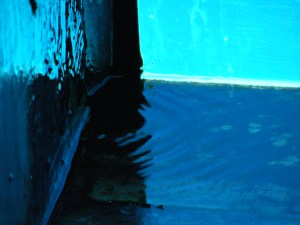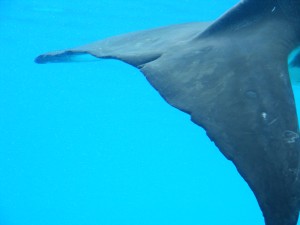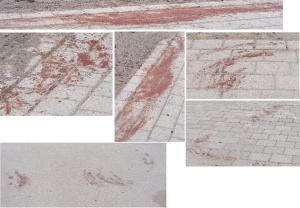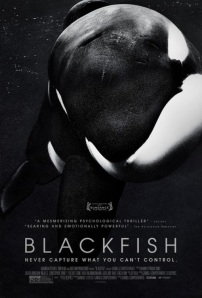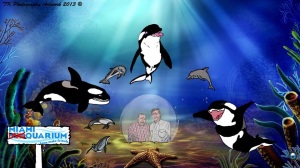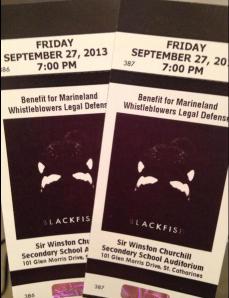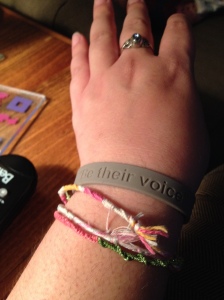Orcas In Captivity
By: Sarah J. Sweedland
Captivity: def; The condition of being imprisoned or confined.
You know that moment when you finally open your eyes to what is going on around you. To what the animals that became so precious to you as a child, are going through now. At one time I thought captivity wasn’t so bad. It gave a chance to breed some of the endangered animals, but the blinders have come off. In fact, they were slapped off my face. Sometimes an activist is born out what we have enjoyed in our youth and grow to fight against in maturity. How else would one know what they’re fighting against and for, if at one time they weren’t somehow part of the problem?
I wrote this huge long article just a few weeks ago, and I was surprised by a few people who actually took the time to read it. Society doesn’t cope well when someone shows them something they know right away they are not going to like. Which is understandable. When my blinders came off in regards to captivity, I made a very difficult vow never again go to an aquarium or zoo again. As an animal lover, especially marine life, and living in southern Ontario, I don’t exactly have a whole lot of access to these animals. I can’t just walk to Lake Ontario and hope to see a pod of Orcas swim by. My only real encounters took place at aquariums. So you’re all probably thinking, what the hell do I know? Well to be honest, first hand, I know very little. But I am taking the time to learn.
I fell in love with orcas, or killer whales as they are more commonly known, when I was young, after a school unit on marine mammals. There was just something majestic about these animals. I was too young to truly understand what made them so special, I just knew that they were indeed, special. As I got older, I read what I could on them, I watched as many documentaries as I could. I wanted to learn about them. I had a dream to be a killer whale trainer. I wanted to be there beside my favourite animals, learning about them and teaching them at the same time. A dream now, I realize, I could have had. Even with just a high school education, I could have had the dream job I had originally wanted at Marineland here in Canada.
I was never really a huge fan of Marineland, I preferred the, and here’s a joke, the spaciousness of Sea World’s facilities. However you cannot hold the animals accountable for where they are living. It’s not their fault.
Recently so much information has come to light about conditions of these places, whether it be water quality, or life span, or training issues or even death. There is so much more that goes on behind the doors at these aquatic parks and, in some cases, traveling sea circus. Either way, when you look at the long run of it all, these animals, do not belong in a concrete prison.
Background:
Orcas are the largest breed of dolphins, and are very intelligent animals. Killer whales are born weighing around four tons and full-grown size depends a lot on their sex; Females can reach up and around six to eight tons, and males can reach up to eight to ten tons. They have a complex social structure, which includes different vocals for different pods. It’s their extensive vocal dialect that really sets them apart. Very much like accents. A pod of orcas dialect in the northern pacific coast off of Vancouver Island, British Columbia will be different of that of a pod of orcas in the Arctic ocean up around Iceland and Finland, and all of their pods will be different from those around New Zealand. It’s not just their different dialects of vocals, but also what they eat and how they hunt.
Like people, orcas are very family oriented and also like people, tend to pass down traditions to the next generation. That would include their vocals, as well as hunting skills. Families stick together from birth to death, but have interactions with other pods of similar nature. You won’t find Resident orcas being social with Transient orcas. The two different types of Orcas don’t get along. Resident orcas hunt fish, and live in larger pods full of family, whereas Transient orcas hunt small dolphins, larger whales that are weak or are young calves, they also feed on seals, sea lions, sea turtles, and other marine life. Unlike their distant and more evolved cousins the Resident orcas, Transients travel in smaller pods. Usually about three orcas per pod. You’re probably thinking that it’s the transient orcas who make interactions with residents difficult, but it’s the exact opposite. Transients have been run-off by a pod of resident orcas multiple times according to different marine biologist. The two different type of whales have also had a difficult time co-existing in captivity.
In the wild, Orcas can live anywhere between 50 to 80 years, but in captivity, they are lucky if they can make it to twenty-five. They are incredible fast swimmers, and get up to 48 km/h in the ocean, and will eat about five-hundred pounds of food a day. Females don’t start breeding until they are close to fifteen years old, and once they start breeding they might produce a new calf every 3 to 10 years, and gestation last 17 months.
“Nature has intended them to live free, exempt from domination.”-Documentary Lolita: Slave To Entertainment
Capture:
Killer Whales are extremely intelligent animals, probably more intelligent then humans. Their brain is five times the size of ours. This makes you wonder how they manage to get themselves captured by us ignoramus’. However, just like humans, these animals have a downfall. Their Achilles heel if you will; curiosity & immense hunger.
With their curiosity and eagerness for food they would swim up to the fishing boats and not realize that nets would be closing in on them as they took scraps. If one family member got trapped, the rest of the family would be near by. Waiting and hoping for the trapped ones release. With all their acrobatic ability you see, you’re probably wondering why these animals don’t just jump over the nets. It’s because they are aware of the dangers, and they try not to get to close to them. They easily could get out but they are smart enough to know that too much can go wrong from just trying.
In the 1960’s the first few whales caught died accidentally in the nets and one died after being tranquilized with at dart. Marineland collectors (not sure if this Marineland in Niagara Falls, or Marineland in California-not the same owner to my knowledge) shot a male orca and a female got tangled in the net with the line getting caught in the boat propeller.
Two of the most well-known “collectors” (as they are called) were Ted Griffin and Don Goldsburry. Griffin and Goldsburry were the first to perfect a method that would be successful. In the 1970s, Goldsburry became the director of collecting for Sea World and was catching orcas in Puget Sound.
Didn’t matter what method these “collectors” used whether it be, harpoons, hoop nets, gill and purse seine nets. Japanese collectors used harpoons, two died within a year and the other lasted only two. The most common method is the drive method. Boats would drive pods of orcas into a shallow inlet inside a cove and draw a net around, sealing them inside. The entire pod would be trapped and selection would begin. If the drive method failed, the “collectors” would use explosives known as seal bombs to drive the whales in with sound. The method used today, is usually done further from the coast line and a purse seine net is used to encircle a couple of whales. Or distraction in the more choppier water around Iceland where they corral herring, and use the escaped fish to lure whales in close enough to encircle them in the nets. Or 700 to 900 pounds of fresh herring are purchased then dumped in front of an approaching pod and then the net is closed around them.
Once in the nets, orcas check the area for possible escape routes, but usually don’t attempt it unless they are older and know about the nets. They will usually chew threw them.
As of 1970, collectors could no longer capture orcas off the coast of Washington State and in 1975 the same rule was placed in British Columbia. When Sea World could no longer purchase orcas from those waters they turned their attention to the waters around Alaska and Antarctica however both locations failed for different reasons. Eventually Sea World and other marine parks started to retrieve their collection of orcas from Iceland. Importing orcas from Iceland still seemed to be difficult for Sea World because of the difficulty of obtaining permits, but they found a loop-hole. They changed the way they brought in orcas by importing on a breeding loan from other establishments. No payment is exchanged.
I had talked about the dolphin drive in Taiji, Japan in a previous article, where they will drive dolphins into a small shallow cove, trap them inside, allow trainers to select dolphins for captivity and then slaughter the rest. However, over the years a lot of marine parks have not purchased dolphins and whales from Taiji because of the way the fishermen do business and the parks are too worried about their reputation.
Any whale deaths that go on during capture for sale into captivity usually go undocumented even though they are suppose to in order for countries to document any changes in pods and groups. Whales are disposed of in a horrific fashion. In 1970, the Puget Sound round-ups, where famous killer whale, Lolita, was captured, saw five deaths during the capture. One was documented at the time, where a mother was trying to get to her baby, who was separated from her, and got tangled in the nets and drowned. The other four were youths and not reported, but instead at night time, they were taken out to see, had their bellies slit open and filled with rocks and anchors tied to their tails and disposed of. A few months later their bodies washed up on shore, which ended any capturing off of Washington State’s coast line.
What is so bad about captivity? It protects the whales from situations like capture. It protects them from pollution and death at the hands of human beings. Not when you put in certain factors. They are not exempt from death at the hands of human beings while in captivity. Their life span is cut short by a considerable amount. They don’t have the social interaction or mental stability or even the physical health they have out in the ocean. Whales and dolphins have been on this planet long before any humans were ever here. They have more rights on this planet then we do. If they can survive billions of years in the ocean, then they can survive a billion more, if that is what is in the plan for them. Taking them out of the ocean, out of their natural habitat, is not beneficial to these amazing animals. It’s detrimental.
Lolita:
“a symbol of man’s irrepressible desire to dominate nature.”-Documentary; Lolita: Slave To Entertainment
On August 8, 1970, has gone down in history as one of the largest captures of orcas. Seven orcas were selected for sale to various marine parks. Two went to Japan, one to France, the United Kingdom, Australia, Texas and Miami.
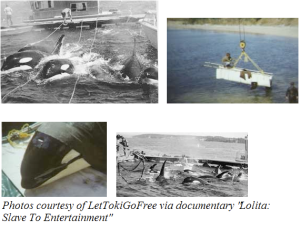
Lolita was about six years of age at the time of her capture. Stolen away from her mother for $6000 and put into a concrete box, where she remains to this very day. Four decades later.
When the pod was trapped, their panicked cries were heard all over the area. Families could hear their cries and it broke their hearts. Shortly after this took place, Washington State banned any future captures. It was just too horrific. Today, Lolita is the only surviving orca from that capture. She is still performing in a pool that is way to small for her.
When she arrived at the Seaquarium in Miami, Florida, she was the second orca on the entire east coast. Right there was a member from her pod from two years before, Hugo. He was a huge male bull, that prior to Lolita’s arrival was kept in a pool that was twelve-feet by twelve-feet.
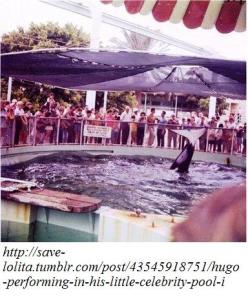
Together they spent ten years together in the pool where Lolita still resides today. Thirty-three years later. Hugo died of a brain aneurysm. Allegedly from ramming into the tank walls. His body was disposed of at the dump. Since then, Lolita has not seen another orca. Occasionally different dolphins are put with her in her tank. A tank that is larger than Hugo’s first tank, but still way too small according to the governing regulations. The deepest point in her pool is only twenty-two feet deep and the width of the pool is thirty-five feet wide and eighty feet across. Lolita is now twenty feet long and over 7,000-pounds and is the largest female in captivity.
The Seaquarium has been facing lower and lower numbers of patrons over the years and Lolita performs one to two shows a day and receives no other training or practice or stimulations because the trainers say she doesn’t need it. She knows her routine so well. Lolita has brought in about $160 million. For over twenty years the Seaquarium keep stating they plan on building a larger and whole new stadium for Lolita but they’re all talk and no action. Truth is, the place doesn’t do enough business to put millions of millions of dollars into building her a larger place to live, since they can’t even repair the stadium where she is now. Not only is she at risk, but so is anyone who visits. In the documentary “Lolita: Slave To Entertainment” one guy takes us behind and under Lolita’s current home. Pipes are leaking, puddles forming near the utility box marked “high voltage” and the stands, right under where people sit, are being held up with construction jacks. The entire place is a hole. Why? Because owner, Arthur Hertz, is too busy lining his pockets. Whether or not he love Lolita, is a moot point. She’s suffering in that pool. She deserves to be free.
Is it safe for her to be released back into the ocean after 43 years in captivity? Renowned Dolphin expert and activist, Ric O’Barry believes it is possible. Marine biologist have kept tabs on her pod (L-25 sub-pod) in Puget Sound. Her mother, who is close if not over, 90-years old is still alive. A while back a journalist played calls from her family in front of Lolita and she immediately responded. Being six when she was captured, she knows her family. She knows what happened to her and remembers what life is like back in the wild. It’s truly tragic what has happened here. She is a rare orca, who has managed to survive 40-plus years in a concrete pool, way to small for her and has beat the odds. Beaten odds that other orcas who are stuck in larger pools, could not beat. Isn’t time to release Lolita? Retire her and reunite her with her family? Myself and many others, say YES!
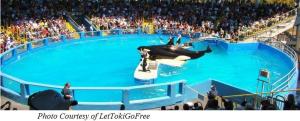
If you’re having problems digesting this, then think about if you were stuck in your bathtub for one week, and once in a while, someone comes in and gives you food. You’ll become highly dehydrated, starving, willing to do anything. If you’re lucky, you might get some warm water added to the chilly waters (not that that part is pertinent to the orcas, it’s just an example of your comfort). If someone said to you, “jump” or “splash”, and offer you food and fresh water to do so, you’ll do it.
Morgan:
The story of Morgan is a hard one to swallow. Actually I really can’t say that because all of these stories are heartbreaking and hard to swallow. Morgan was taken from the wild in Norway in 2010 and was dramatically underweight, yet healthy. The aquarium who captured her had a permit to do a rescue and release. But that never happened. Morgan was eventually put out for the world to see as an exhibit to entertain us humans. She became a vital part of their breeding program being the first orca captured from the wild in twenty-five years.
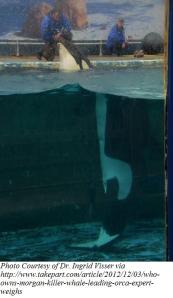
Morgan was kept in a too small tank in the Netherlands from the time she was allegedly rescued until November 2011. The tank wasn’t deep enough for her so when she would do any spy hopping, which is where an orca pokes their head out of the water in an upright position to check out what’s going on, Morgan’s tail would be curled on the floor, much like I had mentioned in my brief description of Hugo from the Seaquarium in Miami.
But like Lolita, Morgan has the support of people. Actually she has the support of an amazing woman, someone who I personally look up to. A woman who is not only a respected, knowledgeable expert on orcas but she loves these animals, Dr. Ingrid Visser. Visser is the founder and head scientist of Orca Research Trust, in New Zealand. Orca Research Trust is an organization based on the dedication of protecting orcas and their habitat. She is currently leading the charge to get Morgan into rehabilitation and then release to re-join her family. Visser is leading a legal team in Morgan’s case. So much could be said about Visser’s fight against the judicial system that it would take up so much room, but if you want to read a detailed account of what is going on with Visser’s legal battle then please do so here; http://www.freemorgan.org/morgan-in-court/
Morgan was eventually moved from her pen at Dolfinarium Harderwijk in The Netherlands and moved to a Sea World owned park in Spain called Loro Parque; http://www.youtube.com/watch?v=sDRWCvi6ytA&feature=youtu.be . Since Morgan’s arrival at the park, she has had a difficult time with the other orcas. She has accumulated over 650 bites and 100, if not more, attacks happed to her while being observed. Some of the attacks were so bad that she was airborne right out of the water. She is constantly sexually harassed by the adult male orca, and the park is trying to breed her despite the her age. She is still an adolescent. Orcas don’t usually start baring a calf until they are fifteen-years old. The captivity industry is so desperate for new DNA from wild orcas that their rushing Morgan. The industry is so full of inbreeding that it might explain the issues they are having with birth defects and loss of life among their current born calves. Some of the other orcas have been involved in numerous attacks that didn’t just occur on Morgan, but with humans. Son of Tilikum, the orca who killed Sea World veteran trainer Dawn Brancheau, a trainer in British Columbia, and quite possibly a civilian who snuck into his pen one night, brutally attacked trainer Claudia Vollhardt, severely injuring her, and son of the original “Baby Shamu”, Keto attacked and killed trainer Alexis Martinez in 2009.
Other than the attacks on Morgan by the other orcas, other physical problems have occurred. She’s so stressed out that she’s jaw popping and biting on the concrete wearing down a third of her front teeth in 19 weeks yet the park she is currently held in are ignoring these issues.
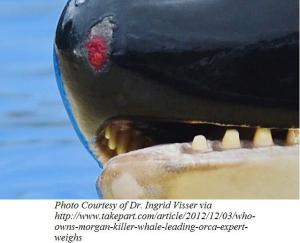
You can help Dr. Ingrid Visser help Morgan, by signing the petition; https://www.change.org/en-GB/petitions/the-dutch-government-authorities-ministry-of-agriculture-re-open-the-case-for-morgan-s-release-back-to-the-wild and joining the Facebook group; http://www.facebook.com/freemorgan.org?ref=ts&fref=ts. As well as on Twitter; @free_morgan.
Nakai:
I remember seeing on twitter that there was an uproar within the orca supporter community. One that I’m a part of. Maybe not officially, but I do love these animals and really want to help out the best I can, so whenever I hear of anything that is wrong on so many levels, I figure out what I can do to help. Like write. I may not be the best with grammar or spelling, and I’m not an educated expert, but I know a lot and I know what is right and what is wrong. So when I heard that there was this orca who people witnessed was getting bullied by some of the other orcas at Sea World, I had to check it out. Some people reported seeing strange behaviour on the Shamu Cam that Sea World has set up on their website. Or should I say, had set up. Recently I went over to the website to check it out and found that they disabled it and the link was no longer there. The only camera they have set up to stream is the Penguin cam.
The whale that was allegedly attacked and bullied by the other orcas is Nakai. An eleven-year old male orca who had this huge gash on his chin, leaving his jawbone exposed.
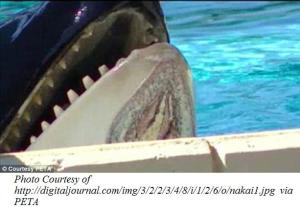
Sea World told media through a statement that Nakai’s injuries were caused when he “came into contact with a portion of the pool environment.”
PETA (People for the Ethical Treatment off Animals) accused Sea World of housing killer whales together who were not compatible, which resulted in Nakai’s injuries. This would be in the direct violation of the Animal Welfare act. This wouldn’t be the first time that Sea World has kept incompatible orcas together. It’s not that they don’t know that they are the same species, but it’s really all in the fact that either the facility has put Transients and Residents together which do not get along, as the larger more familial pod of the Residents chase away Transients before becoming physically aggressive. Sea World had that exact problem before with two males ending in a sever penial injury in the Transient orca. Two females have gone after each other, possibly over the calf belonging to one of them, resulting in death. Part of the problem is that they cannot properly communicate with one another. Being locked in a concrete pool where their calls just bounce and reverberate off the walls and metal bars, doesn’t help and of course it comes down to being a part of different pods in the wild, since every pod in the wild have a different dialect. Also such incompatibility can lead to a huge amount of stress that can result in agitation, raking and other serious injury and that includes death. Nakai is constantly being raked by the others.
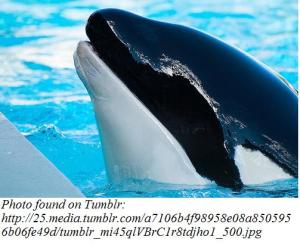
Raking is a way for Killer Whales to show dominance. It’s not uncommon in the wild, just not usually an issue. Aggression shows up in all animals, but for orcas its a bit different. Raking is essentially teeth being used to lead the younger members, maybe discipline them for some reason. Raking does happen in the wild but it’s not as common as it is in captivity. In captivity the whales don’t have anywhere to really go to avoid it, and from various accounts that I’ve read about it’s definitely more of an aggression or boredom thing.
The trainers said that they didn’t even notice the injury to Nakai until they went to feed him, and that’s when they discovered the huge open gash in his chin. The chunk was retrieved from the bottom of the pool later. They claim that it happened during the show and that he had a run-in with the side of the pool. But it was later noticed that the gash had teeth marks around the edges.
Marineland’s Kiska & Junior and Sea World’s Tilikum:
I have already talked quite a bit about both Kiska and Tilikum. Probably the two killer whales that I’m going to make share a section only because I talked about them in my last article; Found here http://scienceray.com/biology/the-effects-of-captivity-the-links-to-horror-to-cetaceans-pinnipeds/. But there are some details that I didn’t get talk about. Some I didn’t know at the time. Mostly about Marineland’s Kiska and Junior. Junior is new to this entire article. One I feel should be included in the talk of Marineland.
Kiska comes from Iceland like many of the current Killer Whales imprisoned at various marine parks around the world. She was captured in 1979 along with three others; King, Caren and another female who was unnamed. Kiska and the one female were sold to Marineland, in Niagara Falls, Ontario. The other female was then transferred to Kamogawa but died shortly after. Kiska was joined by Nootka V, Kandu VII and Junior. Kiska had five calves by Kandu VII; one died after 62 days by drowning, Kanuck lived for 4 years but died of traumatic shock and Nova who was born in 1996 and died in 2001 of pneumonia and starvation, in 1998 Hudson was born but died in 2004 of meningitis, and Athena born in 2004. After Kandu VII died on Christmas eve in 2005, Nootka V joined Kiska but tried to steal Athena away. During that time, Kiska was separated from her calf until Nootka died in 2008. She was then reunited with Athena and Marineland brought in Sea World’s Ikaika, also known as Ike to help with breeding. Ike and Athena got along until Athena’s death in 2009. Kiska is now alone, but retired from show as she is now 39 years of age. Probably one of the second oldest whales in captivity. Sea World and Marineland engaged in a nasty custody battle over Ike as he was on loan to Marineland for breeding but Sea World didn’t like the way he was being used and were also not impressed with the facilities. They won the battle and Ike is in San Diego as of November 2011. Kiska now remains alone, floating around the back pool of Friendship Cove.
Her former trainer spoke up about the care, or lack there of, for Kiska. Christine Santos worked for years with Kiska but was fired from her job in October 2012 for not signing a document presented to her that would denounce any claims of animal abuse going on at the park. After refusing to sign it, she was fired. To know more you can visit here; http://timzimmermann.com/2012/10/18/the-life-of-kiska/
Marineland’s Junior is a sad story. One that turns my stomach. Now a lot of the stories I have heard come through so many different channels that it’s hard to tell where we all got the information from. A lot of the information I found came from Marineland Animal Defense on Twitter also known as M.A.D.. They have done several posts regarding Junior and his story which was backed up by a video taken by Pawel Dwuilt and Cara Sands. Junior was captured in 1984 at the age of two and brought to Marineland. He was bullied and harassed by the other orcas. They removed Junior from the main tank and put him in a small, concrete holding tank in the dreaded “Barn”. A closed up building with no sunlight, no fresh air, nothing. It’s literally hell for these animals. He was kept there in isolation for the last four years of his life. For four years he never saw another Killer Whale. Occasionally he would share the small concrete tank with a dolphin or two but that was it.
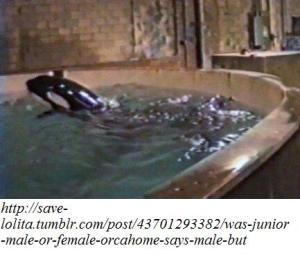
In April of 1994, Cara Sands and Pawel Dwuilt recorded footage describing the turn around in Junior. Outside of the dreaded “Barn” warehouse were construction vehicles, the smell of gasoline in the air. Inside was just Junior, all along. Floating in his concrete holding cell. When he saw the camera, he opened his mouth but when he realized she had nothing for him he rolled back over. He was virtually unresponsive. Neglected and abused. A true heartbreaking story. A whale that was stuck in a concrete prison for the last 4 years of his life. Junior spent 9 ½ years in captivity, four of that was in isolation. Solitary confinement. Away from life. Abused, neglected, and he died that way. He died alone in July of 1994 at the age of 13. There is rumours, although no concrete evidence, that he was not only lethargic but he had become psychotic as well. He died of brain damage.
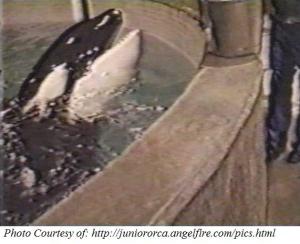
All because John Holer, the owner of Marineland, couldn’t find a use for him, couldn’t find a buyer from another park for Junior. When nothing happened where Holer could financially benefit from Junior, he let him die in that tank instead of doing what was right and releasing him. This story breaks my heart. Maybe more than the others, just because no animal should ever die alone. No animal should ever be treated this way. He was essentially being punished for being bullied by the other whales, and being punished because Holer couldn’t make a buck on him. All Junior ever did was try to live his life free in the ocean only to get caught and taken to a place he didn’t want to be a part of.
Another connection to Marineland is probably the most famous one. The star of the movie Free Willy, Keiko, was kept at Marineland briefly in 1985, and he too was kept in the infamous “Barn” warehouse. In the same small concrete pen where Junior was imprisoned in for the last 4 years of his life. Keiko was then moved to Reino Adventura in Mexico City. And his story can be found here; http://www.orcanetwork.org/captivity/keikostory.html this is a very captivating life story of an orca who became one of the most famous in the world.
Sea World’s Tilikum, a large male bull, has a very sordid past of his own. He allegedly has killed three people out of four people killed by orcas while in captivity. One was in Vancouver, British Columbia, Sealand of The Pacific where Tilikum and two female Orcas were in their sea pen and one of their trainers slipped in. At Sealand, they didn’t allow trainers to do water work with the orcas, so they weren’t used to having someone in the water with them. The two females were apparently pretty aggressive at times. The trainer slipped and fell in and a few accounts of the story was that the two females started playing with her roughly and Tilikum joined in but she was already dead. Another few accounts were that she slipped in and Tilikum killed her. Nothing substantial has been ever proven that they death was deliberate whether it be Tikikum’s fault or one of the two females. The second death was a civilian man who managed to allude security at Sea World in Orlando and managed to get into the back pool where Tilikum was and was found the next morning dead in the water. Apparently he died of hypothermia and had some abrasions on his body. A few teeth marks. Again, there is nothing to substantiate the claims that Tilikum killed the man.
The problem with these two deaths is…these whales are in captivity. They need constant stimulation. They are so aware and so intelligent that if their brain isn’t being constantly challenged, boredom sets in. They see someone or something in the water in front of them, they are going to play with it. Human being, seal, dolphin, whatever.
The third account, there is no doubt that Tilikum killed the trainer. Dawn Brancheau woke up one morning went to work to work with the animals she loved. She never returned home to her family on February 24, 2010. She was laying next to Tilikum, a 12, 000 pound male orca during a Dine with Shamu show. What happened next was not the happy tail that someone who visited the park would be telling. No what happened was, Tilikum grabbed Dawn by the pony tail or arm, nobody really knows exactly and pulled her into the water where the assault happened. She was dragged and tossed and shakened around by Tilikum. She suffered multiple broken bones and scrapes but by the time they could get to her, she was gone. Nobody knows why he decided to attack her. All she did was touch him on the nose and was spending time with him when he turned on her.

Tilikum is a wild animal. Orca who knows he isn’t where he suppose to be. When you go through what these animals go through, you’re bound to be pissed off. Before Dawn there was Keltie Byrne at Sealand of The Pacific, and a trainer from the aforementioned Loro Parque in Spain, when another Killer Whale who was on loan from Sea World killed trainer Alexis Martinez, just two months before Dawn Brancheau’s death.
Conclusion:
These animals have to endure the stress of capture, the stress of being transfered from ocean to a small tank that is not even close to the size of body of water they are used to swimming in. They have to have their teeth drilled and flushed out daily so they won’t get bacteria infections which can kill them, they have to take pills in frozen fish because many suffer from ulcers or depression. They are forced to perform tricks for an audience of people for what? Food. No performance, no food. These are animals that are used to eating 800 pounds of fish just for a snack. They float listlessly in between shows, they suffer from dehydration that they would normally get from eating fresh fish, but now rely on eating it in a gelatin form. Mother’s are often separated from their babies and most of the time the calves are lucky to survive at all. Natural breeding rarely happens in captivity. Male orcas are masturbated by a human into a plastic sterile bag that is eventually used to inseminate a female orca. Some, like Junior, are being neglected and abused, dying of starvation, dehydration, drowning, brain aneurysms, meningitis, heart disease, pneumonia, respiratory infections, Perforated Stomach due to Ingesting Sand from the Tank Filters, septicemia, fungus’, shock, abscesses, salmonella, West Nile Virus, and many other problems that most in the wild don’t die from. The stress leads to raking and jaw popping (chewing on the metal bars of the gates or cement edges of the pools).
In the United Kingdom, there are no longer whales and dolphins allowed to be kept in captivity. The country has been a captivity free zone for whales and dolphins since the early 1990’s. In the early 90’s the public opinion changed on the subject. Seeing whales and dolphins as intelligent life and living in a unnatural environment. One that they are forced to entertain humans. It became a moral issue about keeping the large animals in too small of space. It wasn’t for education or research like many marine parks claim they are in the business off. Those animals were in there to bring in the money for the greedy humans who trapped and imprisoned these animals. The United Kingdom are setting the right example of making this a possibility for other countries to follow. Have many countries followed the example put forth by this royal country? There are still 59 aquariums in all of Europe. There are more than 183 dolphinariums around the world. But there are none in the United Kingdom. They are the leading country in anti-captivity of whales and dolphins.
Doesn’t this make you think? You don’t need to have live whales and dolphins to perform for us. The one thing that comes with this day and age is technology. So many different ways for these parks to make money. Instead of stealing from the world’s oceans and upsetting our eco-system, why not install iMax theatres all around in the place of these aquariums and dolphinariums, show and educate people by using real footage of these animals in their natural habitat. If you must, show footage of the ones who were enslaved for decades and honour them that way by putting their names and the facts of when they were brought into captivity, how many years they worked to entertain the human race and when they died or hopefully released. It is such a much more balanced idea for these animals. Appreciation for them will be the same. There is so much that technology can do to help educate us now that I feel sometimes it’s not being utilized to it’s fullest capacity. This is one way that we could use technology to our and the whales advantages.
If you’re thinking that release all these whales and dolphins can’t be done, you’re so wrong. Look up Keiko, Springer and Luna. It may not always be successful to release these amazing animals back into their habitat but it gives them the choice whether or not to die with their dignity and die with their families. It gives them that choice to thrive and survive. To see what they were missing. It is possible to rehabilitate them and set them back in the ocean.
After Keiko’s release, Arther Hertz of the Seaquarium in Miami, put in a permit to re-capture him to bring him to reside with Lolita. The Norwegian Ambassado, Knut Volleback denied the permit, stating:
“Keiko now has a freedom that makes it possible for him to make choices. It would be a step back to put him in an aquarium again.”
Just recently dolphin advocate, Ric O’Barry has been working very closely with Jakarta Animal Aid Network in Indonesia on getting the dolphins released by initiating a rehabilitation program that will help integrate them back into the wild. Many of the dolphins in Indonesia are in these horrible traveling circus’ http://vimeo.com/29454682 and have been illegally poached from the ocean. JAAN and Ric O’Barry’s Dolphin Project have constructed the sea pen for the dolphins rehabilitation. A few weeks ago the forestry minister Zulkifili Hasan met with Ric O’Barry and members of JAANto discuss his willingness to shut these traveling circus’ down and release the dolphins to their care for rehabilitation and release. Such a great step in the right direction… Until, the day that two dolphins were suppose to be released into JAAN and O’Barry’s care, the dolphins go missing. Made and Wayan, two dolphins who were kept in a small and very filthy tank at a restaurant in Bali were taken, before they could be transfered to the sea pens. They followed a truck carrying the two stolen dolphins for 20 hours but JAAN and O’Barry don’t know if the dolphins arrived dead or alive as they couldn’t get anywhere near the place. All that was going on by the Minister of Fisheries was apparently lip service as he isn’t responding to what’s going on despite his willingness to work with JAAN and O’Barry. When O’Barry and JAAN withe the US Ambassador met with the Hasan, they were in need of body guards and bulletproof vests to keep them safe. Made and Wayan have not been released yet. We still don’t know if they even survived.
The problem is this; Owners and investors are not going to be up to releasing their dolphins and whales. There is too much money to be made by exploiting these animals. That is why in countries like Indonesia, Ric O’Barry and many other activists put their lives at risk. To be made to wear a bulletproof vest just to leave a building, isn’t something to be taken lightly. When money is involved, nobody’s welfare or safety means anything. The animals welfare and safety means nothing. It’s greed and selfishness on the part of the owners of these sea prisons. All they see are dollar bills. Arther Hertz, who “owns” Lolita, has been offered a lot of money for her so that she can be released. He won’t budge. She’s the only thing he has that is bringing money into that shabby little dolphinarium he owns. Lolita is nothing but his cash cow. And that’s sad. She’s 49 years of age and should be retired. Retired back to her family in Puget Sound. Today she’s performing up to two shows a day. Kiska is retired but what is she doing? She’s not bringing in money by not performing for Marineland, instead she’s swimming around her pool. Alone. Like Lolita.
There are just so many reasons as to why I want these gorgeous, intelligent animals released. I want them to live the rest of their lives in freedom. The way they are suppose be living. Not in prison.
So what would you choose?
Prison?
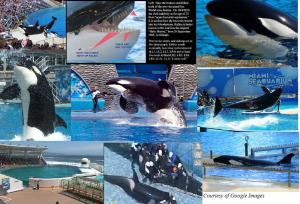
Or Freedom?
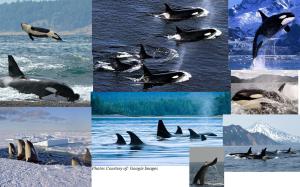
I choose Freedom!
To achieve this there are so many things you can do. You can write to your government, urging the issue of freeing these animals from being in captivity and have them released back to the oceans. But you can start by not buying a ticket!
“There is as much educational benefit in studying dolphins in captivity as there would be studying mankind by only observing prisoners in solitary confinement.”
-Jacques Cousteau
Resources:
Capture:
-Chapter 3 of The Performing Orca-Why the Show Must Stop by Erich Hoyt, Whale and Dolphin Conservation Society, Bath U.K. 1992
Lolita:
–Documentary; Lolita: Slave To Entertainment (2006)
–www.freewebs.com/let_toki_go_free/lolitasstory.htm
Morgan:
–http://www.freemorgan.org/morgan-2
-Author David Kirby talks to Marine Biologist and leading Orca expert, Dr. Ingrid Visser: http://www.takepart.com/article/2012/12/03/who-owns-morgan-killer-whale-leading-orca-expert-weighs
–http://www.freemorgan.org/morgan-in-court/
–https://www.change.org/en-GB/petitions/the-dutch-government-authorities-ministry-of-agriculture-re-open-the-case-for-morgan-s-release-back-to-the-wild
–http://www.youtube.com/watch?v=sDRWCvi6ytA&feature=youtu.be
–http://www.facebook.com/freemorgan.org?ref=ts&fref=ts
-Twitter: @free_morgan
Nakai:
–http://www.dailymail.co.uk/news/article-2211159/SeaWorld-Killer-whale-suffers-mysterious-injury-prompting-fury-animal-rights-groups.html
Marineland’s Kiska & Junior and Sea World’s Tilikum:
–http://timzimmermann.com/2012/10/18/the-life-of-kiska/
–http://www.thestar.com/news/2012/08/25/the_story_of_marineland_s_junior.html
–https://twitter.com/marinelandAD
–http://www.orcanetwork.org/captivity/keikostory.html
-http://www.cbsnews.com/stories/2011/03/31/earlyshow/living/petplanet/main20049150.shtml
–-http://www.themeparkinsider.com/flume/201103/2414/
–http://www.seaworldofhurt.com/ten-things.aspx
–http://www.dailymail.co.uk/news/article-2175966/Killer-whales-Seaworld-teeth-removed-power-drills-left-mourn-separated-young-claims-shocking-new-book.html
–http://abcnews.go.com/GMA/seaworld-trainer-dawn-brancheau-suffered-broken-jaw-fractured/story?id=10252808
–http://www.huffingtonpost.com/tim-zimmermann/death-at-loro-parque-the-_b_902863.html
CONCLUSION:
–http://www.marineconnection.org/campaigns/captivity_captive_free.html
–http://www.bornfree.org.uk/campaigns/zoo-check/captive-whales-dolphins/
–http://www.wdcs.org/stop/captivity/index.php
–http://dolphinproject.org/take-action/indonesia-campaign
–http://dolphinproject.org/blog/post/meeting-with-the-indonesian-minister
–http://dolphinproject.org/blog/post/dolphins-made-and-wyan-in-bali-kidnapped
–http://dolphinproject.org/blog/post/good-news-and-bad-news-in-indonesia
